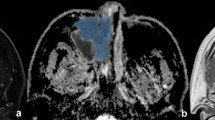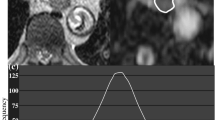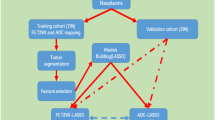Abstract
Purpose
Accurate histologic grade assessment is helpful for clinical decision making and prognostic assessment of sinonasal squamous cell carcinoma (SNSCC). This research aimed to explore whether whole-tumor histogram analysis of apparent diffusion coefficient (ADC) maps with machine learning algorithms can predict histologic grade of SNSCC.
Methods
One hundred and forty-seven patients with pathologically diagnosed SNSCC formed this retrospective study. Sixty-six patients were low-grade (grade I/II) and eighty-one patients were high-grade (grade III). Eighteen histogram features were obtained from quantitative ADC maps. Additionally, the mean ADC value and clinical features were analyzed for comparison with histogram features. Machine learning algorithms were applied to build the best diagnostic model for predicting histological grade. The receiver operating characteristic (ROC) curve was used to evaluate the performance of each model prediction, and the area under the ROC curve (AUC) were analyzed.
Results
The histogram model based on three features (10th Percentile, Mean, and 90th Percentile) with support vector machine (SVM) classifier demonstrated excellent diagnostic performance, with an AUC of 0.947 on the testing dataset. The AUC of the histogram model was similar to that of the mean ADC value model (0.947 vs 0.957; P = 0.7029). The poor diagnostic performance of the clinical model (AUC = 0.692) was improved by the combined model incorporating histogram features or mean ADC value (P < 0.05).
Conclusion
ADC histogram analysis improved the projection of SNSCC histologic grade, compared with clinical model. The complex histogram model had comparable but not better performance than mean ADC value model.




Similar content being viewed by others
Availability of data and materials
The authors declare that the data are available.
Code availability
The authors declare that the custom code can be available.
Abbreviations
- SNSCC:
-
Sinonasal squamous cell carcinoma
- HNSCC:
-
Head and neck squamous cell carcinoma
- DWI:
-
Diffusion-weighted imaging
- ADC:
-
Apparent diffusion coefficient
- RESOLVE:
-
Readout-segmented echo-planar imaging sequence
- SMOTE:
-
Synthetic minority oversampling technique
- PCC:
-
Pearson correlation coefficient
- ANOVA:
-
Analysis of variance
- KW:
-
Kruskal–Wallis
- RFE:
-
Recursive feature elimination
- SVM:
-
Support vector machine
- LDA:
-
Linear discriminant analysis
- LR:
-
Logistic regression
References
Turner JH, Reh DD (2012) Incidence and survival in patients with sinonasal cancer: a historical analysis of population-based data. Head Neck 34:877–885. https://doi.org/10.1002/hed.21830
Quan H, Yan L, Zhang H et al (2019) Development and validation of a nomogram for prognosis of sinonasal squamous cell carcinoma. Int Forum Allergy Rhinol 9:1030–1040. https://doi.org/10.1002/alr.22354
Roland NJ, Caslin AW, Nash J et al (1992) Value of grading squamous cell carcinoma of the head and neck. Head Neck 14:224–229. https://doi.org/10.1002/hed.2880140310
Larsen SR, Johansen J, Sørensen JA et al (2009) The prognostic significance of histological features in oral squamous cell carcinoma. J Oral Pathol Med 38:657–662. https://doi.org/10.1111/j.1600-0714.2009.00797.x
Ackall FY, Issa K, Barak I et al (2021) Survival outcomes in sinonasal poorly differentiated squamous cell carcinoma. Laryngoscope 131:E1040–E1048. https://doi.org/10.1002/lary.29090
Pfister DG, Spencer S, Adelstein D et al (2020) Head and neck cancers, version 2.2020, NCCN clinical practice guidelines in oncology. J Natl Compr Canc Netw 18:873–898. https://doi.org/10.6004/jnccn.2020.0031
Gencturk M, Ozturk K, Caicedo-Granados E et al (2019) Application of diffusion-weighted MR imaging with ADC measurement for distinguishing between the histopathological types of sinonasal neoplasms. Clin Imaging 55:76–82. https://doi.org/10.1016/j.clinimag.2019.02.004
Yun TJ, Kim J, Kim KH et al (2013) Head and neck squamous cell carcinoma: differentiation of histologic grade with standard- and high-b-value diffusion-weighted MRI. Head Neck 35:626–631. https://doi.org/10.1002/hed.23008
Just N (2014) Improving tumour heterogeneity MRI assessment with histograms. Br J Cancer 111:2205–2213. https://doi.org/10.1038/bjc.2014.512
Meyer HJ, Leifels L, Hamerla G et al (2018) ADC-histogram analysis in head and neck squamous cell carcinoma. Associations with different histopathological features including expression of EGFR, VEGF, HIF-1α, Her 2 and p53. A preliminary study Magn Reson Imaging 54:214–217. https://doi.org/10.1016/j.mri.2018.07.013
Ren J, Yuan Y, Tao X (2022) Histogram analysis of diffusion-weighted imaging and dynamic contrast-enhanced MRI for predicting occult lymph node metastasis in early-stage oral tongue squamous cell carcinoma. Eur Radiol 32:2739–2747. https://doi.org/10.1007/s00330-021-08310-0
Perrot TD, Lenoir V, Ayllón MD et al (2017) Apparent diffusion coefficient histograms of human papillomavirus-positive and human papillomavirus-negative head and neck squamous cell carcinoma: assessment of tumor heterogeneity and comparison with histopathology. AJNR Am J Neuroradiol 38:2153–2160. https://doi.org/10.3174/ajnr.A5370
Srinivasan A, Chenevert TL, Dwamena BA et al (2012) Utility of pretreatment mean apparent diffusion coefficient and apparent diffusion coefficient histograms in prediction of outcome to chemoradiation in head and neck squamous cell carcinoma. J Comput Assist Tomogr 36:131–137. https://doi.org/10.1097/RCT.0b013e3182405435
Tsuchiya N, Doai M, Usuda K et al (2017) Non-small cell lung cancer: Whole-lesion histogram analysis of the apparent diffusion coefficient for assessment of tumor grade, lymphovascular invasion and pleural invasion. PLoS ONE 12:e0172433. https://doi.org/10.1371/journal.pone.0172433
Xue H, Ren C, Yang J et al (2014) Histogram analysis of apparent diffusion coefficient for the assessment of local aggressiveness of cervical cancer. Arch Gynecol Obstet 290:341–348. https://doi.org/10.1007/s00404-014-3221-9
Donati OF, Mazaheri Y, Afaq A et al (2014) Prostate cancer aggressiveness: assessment with whole-lesion histogram analysis of the apparent diffusion coefficient. Radiology 271:143–152. https://doi.org/10.1148/radiol.13130973
Nougaret S, Reinhold C, Alsharif SS et al (2015) Endometrial cancer: combined MR volumetry and diffusion-weighted imaging for assessment of myometrial and lymphovascular invasion and tumor grade. Radiology 276:797–808. https://doi.org/10.1148/radiol.15141212
Bonello L, Preda L, Conte G et al (2016) Squamous cell carcinoma of the oral cavity and oropharynx: what does the apparent diffusion coefficient tell us about its histology? Acta Radiol 57:1344–1351. https://doi.org/10.1177/0284185115587734
Surov A, Meyer HJ, Winter K et al (2018) Histogram analysis parameters of apparent diffusion coefficient reflect tumor cellularity and proliferation activity in head and neck squamous cell carcinoma. Oncotarget 9:23599–23607. https://doi.org/10.18632/oncotarget.25284
Song Y, Zhang J, Zhang Y et al (2020) FeAture explorer (FAE): a tool for developing and comparing radiomics models. PLoS ONE 15:e0237587. https://doi.org/10.1371/journal.pone.0237587
Ren J, Qi M, Yuan Y et al (2020) Machine learning-based MRI texture analysis to predict the histologic grade of oral squamous cell carcinoma. AJR Am J Roentgenol 215:1184–1190. https://doi.org/10.2214/AJR.19.22593
Dik EA, Ipenburg NA, Kessler PA et al (2018) The value of histological grading of biopsy and resection specimens in early stage oral squamous cell carcinomas. J Craniomaxillofac Surg 46:1001–1006. https://doi.org/10.1016/j.jcms.2018.03.019
Lin N, Yu S, Xia Z et al (2022) Apparent diffusion coefficient-based radiomic nomogram in sinonasal squamous cell carcinoma: a preliminary study on histological grade evaluation. J Comput Assist Tomogr 46:823–829. https://doi.org/10.1097/RCT.0000000000001329
Alabi RO, Youssef O, Pirinen M et al (2021) Machine learning in oral squamous cell carcinoma: current status, clinical concerns and prospects for future—a systematic review. Artif Intell Med 115:102060. https://doi.org/10.1016/j.artmed.2021.102060
Fujima N, Shimizu Y, Yoshida D et al (2019) Machine-learning-based prediction of treatment outcomes using MR imaging-derived quantitative tumor information in patients with sinonasal squamous cell carcinomas: a preliminary study. Cancers (Basel) 11:800. https://doi.org/10.3390/cancers11060800
Surov A, Meyer HJ, Wienke A (2017) Correlation between apparent diffusion coefficient (ADC) and cellularity is different in several tumors: a meta-analysis. Oncotarget 8:59492–59499. https://doi.org/10.18632/oncotarget.17752
Woo S, Cho JY, Kim SY et al (2014) Histogram analysis of apparent diffusion coefficient map of diffusion-weighted MRI in endometrial cancer: a preliminary correlation study with histological grade. Acta Radiol 55:1270–1277. https://doi.org/10.1177/0284185113514967
Bozdağ M, Er A, Çinkooğlu A (2021) Histogram analysis of ADC maps for differentiating brain metastases from different histological types of lung cancers. Can Assoc Radiol J 72:271–278. https://doi.org/10.1177/0846537120933837
Ren J, Qi M, Yuan Y et al (2021) Radiomics of apparent diffusion coefficient maps to predict histologic grade in squamous cell carcinoma of the oral tongue and floor of mouth: a preliminary study. Acta Radiol 62:453–461. https://doi.org/10.1177/0284185120931683
Ahn SJ, Choi SH, Kim Y et al (2012) Histogram analysis of apparent diffusion coefficient map of standard and high B-value diffusion MR imaging in head and neck squamous cell carcinoma: a correlation study with histological grade. Acad Radiol 19:1233–1240. https://doi.org/10.1016/j.acra.2012.04.019
Author information
Authors and Affiliations
Corresponding author
Ethics declarations
Conflict of interest
This research did not receive any specific grant from funding agencies in the public, commercial, or not-for-profit sectors.
Ethical approval
This study was approved by the institutional review board of our university hospital and written consent was obtained from each patient.
Additional information
Publisher's Note
Springer Nature remains neutral with regard to jurisdictional claims in published maps and institutional affiliations.
Rights and permissions
Springer Nature or its licensor (e.g. a society or other partner) holds exclusive rights to this article under a publishing agreement with the author(s) or other rightsholder(s); author self-archiving of the accepted manuscript version of this article is solely governed by the terms of such publishing agreement and applicable law.
About this article
Cite this article
Geng, Y., Hong, R., Cheng, Y. et al. Whole-tumor histogram analysis of apparent diffusion coefficient maps with machine learning algorithms for predicting histologic grade of sinonasal squamous cell carcinoma: a preliminary study. Eur Arch Otorhinolaryngol 280, 4131–4140 (2023). https://doi.org/10.1007/s00405-023-07989-9
Received:
Accepted:
Published:
Issue Date:
DOI: https://doi.org/10.1007/s00405-023-07989-9




